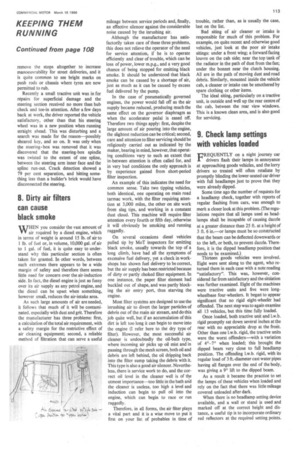8. Dirty air filters can cause black smoke
Page 115

If you've noticed an error in this article please click here to report it so we can fix it.
EN you consider the vast amount of 1air required by a diesel engine, which in terms of weight is around 15 lb. of air to 1 lb. of fuel or, in volume, 10,000 gal. of air to 1 gal. of fuel, it is quite easy to understand why this particular section is often taken for granted. In other words, between such extremes there appears to be a wide margin of safety and therefore there seems little need for concern over the air-induction side. In fact, the diesel engine is just as fussy over its air supply as any petrol engine, and the diesel can be upset when something, however small, reduces the air-intake area.
As such large amounts of air are needed, it follows that much of it will be contaminated. especially with dust and grit. Therefore the manufacturer has three problems: first, a calculation of the total air requirement, with a safety margin for the restrictive effect of air cleaning equipment; second, a reliable method of filtration that can serve a useful mileage between service periods and, finally, an effective silencer against the considerable noise caused by the inrushing air.
Although the manufacturer has satisfactorily taken care of these three problems, this does not relieve the operator of the need for service attention, if he is to operate efficiently and clear of trouble, which can be loss of power, lower m.p.g., and a very good chance of being stopped for emitting black smoke. It should be understood that black smoke can be caused by a shortage of air, just as much as it can be caused by excess fuel delivered by the pump.
In the case of pneumatically governed engines, the power would fall off as the air supply became reduced, producing much the same effect on the governor diaphragm as when the accelerator pedal is eased off. Therefore two things apply: first, despite the large amount of air pouring into the engine, the slightest reduction can be critical; second, care and attention to filter servicing should be religiously carried out as indicated by the maker, bearing in mind, however, that operating conditions vary to such an extent that in-between attention is often called for, and in very bad conditions the only approach is by experience gained from short-period filter inspection.
An example of this indicates the need for common sense. Take two tipping vehicles, both identical, one operating on main road tarmac work, with the filter requiring attention at 3,000 miles, the other on site work from slag tips, and working in a constant dust cloud. This machine will require filter attention every fourth or fifth day, otherwise it will obviously be smoking and running raggedly.
On several occasions diesel vehicles pulled Up by MoT inspectors for emitting black smoke, usually towards the top of a long climb, have had all the symptoms of excessive fuel delivery, yet a check in workshops has shown fuel delivery to be correct, but the air supply has been restricted because of dirty or partly choked filter equipment. In one instance, the paper filter element had buckled out of shape, and was partly blocking the air entry port, thus starving the engine.
Most filter systems are designed to use the inrushing air to divert the larger particles of debris out of the main air stream, and do this job quite well, but if an accumulation of this dirt is left too long it can begin to move into the engine (I refer here to the dry type of filter). However, the most successful air cleaner is undoubtedly the oil-bath type, where incoming air picks up oil mist and in passing through the mesh screen, both oil and debris are left behind, the oil dripping back into the filter sump taking the debris with it. This type is also a good air silencer. Nevertheless, there is service work to do, and the correct oil level in the cleaner well is of the utmost importance—too little in the bath and the cleaner is useless, too high a level and induction can begin to pull oil into the engine, which can begin to race or run raggedly.
Therefore, in all forms, the air filter plays a vital part and it is a wise move to put it first on your list of probables in time of trouble, rather than, as is usually the case, last on the list.
Bad siting of air cleaner or intake is responsible for much of this problem. For example, on quite recent and otherwise good vehicles, just look at the poor air intake sitings: under a front wing; a forward facing louvre on the cab side; near the top tank of the radiator in the path of dust from the fan; under the bonnet near the clutch housing. All are in the path of moving dust and road debris. Similarly, mounted inside the vehicle cab, a cleaner or intake can be smothered by spare clothing or other items.
The ideal siting, particularly on a tractive unit, is outside and well up the rear centre of the cab, between the rear view windows. This is a known clean area, and is also good for servicing.




































































































































































